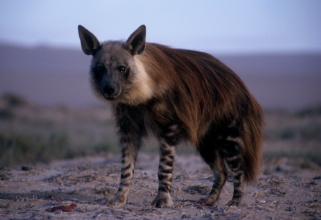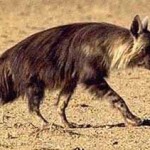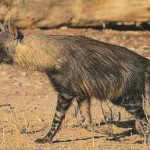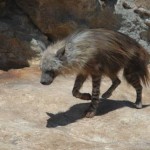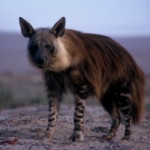Brown Hyenas Facts
Scientific Classification of Brown Hyena: Hyaena Brunnea
Kingdom of Brown Hyena: Animalia
Phylum of Brown Hyena: Chordata
Class of Brown Hyena: Mammalia
Order of Brown Hyena: Carnivora
Family of Brown Hyena: Hyaenidae
Genus of Brown Hyena: Hyaena
Species of Brown Hyena: H.brunnea
Brown Hyena
The Brown Hyena is commonly found in the regions of South Africa and surrounding countries. These species are sparingly found these days and pose the danger of extinction. As compared to other common hyenas, brown hyenas have somewhat of a shaggy look.
Pictures of Brown Hyenas
Some Interesting Facts about Brown Hyena
Brown Hyenas have typical behavioral traits and a few of them have been detailed here:
- The absence of any other powerful species in Kalahari Desert, makes these species the strongest in the region. They imitate the calls of other hyenas and laugh in response to their calls.
- They are carnivorous by nature but not as skilled hunters. These species attack small animals like springhare, bat eared fox, springbok, lamb.
- They attack human beings only when they sense something wrong.
- These species mate within their own groups. The females prefer to mate dominant males.
Distribution of Brown Hyenas
These species are actually found in the southeastern & southern parts of Africa including countries of Namibia, Southern and Western regions of South Africa, Botswana, Zimbabwe and Mozambique.
Characteristics of Brown Hyenas
Size of Brown Hyenas: The size of these species varies from 34 to 59 inches. The average length of these species are from 110 to 125 cm.The females are slightly smaller than the males.
Height of Brown Hyenas: The height of their shoulder varies from 71 cm to 88 cm.
Weight of Brown Hyenas: Weight of elder males varies from 40.2 to 43.7 kilograms while the female counterparts weigh 37.7 kg – 40.2 kg.
Color of Brown Hyenas: The fur of their body is dark brown while the color of their head is grey. Moreover, the grey colored legs have horizontal stripes on it.
Body of Brown Hyenas: In case of these species the neck and the back portion is wrapped around with long fur while the tail and back have rather shaggy fur.
Head of Brown Hyenas: The striped hyenas have a large skull.
Teeth of Brown Hyenas: The teeth of these species are strong. However, the power of jaws diminishes as the teeth get delicate with age.
Behavior of Brown Hyenas
We catch up with certain behavioral features of these species
- These species stay active mostly during nighttime and are usually found in groups of 5 – 15 members. Usually these species hunt alone during the nighttime. If necessary, they create clans.
- These species run after the leopards and attack them with their big jaws. In this way, they grasp the victim. They also maintain social power consisting of alpha male and female. This power is retained with the help of the ritualized fights as well as aggression.
- These species spot their territory with the help of an anal secretion. However they travel long distances in quest for food.
- When aggressive or defensive their fur stands straight.
Food Habits of Brown Hyenas
The species like to have carcasses in their diet. They also prefer rodents, insects, fruits and small mammals. They can also be found thriving on cheetahs, black-backed jackals and the leopards.
Habitats of Brown Hyenas
These species live in the arid areas of the scrublands, savannahs, semi desert regions of the southern Africa and grasslands. The range of their territory is restricted within 233 – 466 sq. miles.
Mating Season of Brown Hyenas
These species do not stick to any particular season for mating rather they can mate all the year round.
Reproduction of Brown Hyenas
- These species get sexually matured at the age of 2 or 3. The females usually mate with males of their group. The pregnancy period lasts for 97 days. The males usually assist their partners for a good upbringing of the babies.
- The mother gives birth to 1 – 5 offspring somewhere in the outskirts of sand dunes protected from other hyenas and lions. Usually the cubs weigh 1 kg at birth. The female reproduces every 20 months. It is mostly the powerful females who reproduce.
Life Cycle of Brown Hyenas
- When 3 months old, the babies start feeding on solid foods. At this time, the mother usually shifts into their caves. The mother including the rest of the partners arranges food for the babies.
- The eyes of the baby brown hyenas are closed when they are born. They usually open their eyes after 8 days from their birth. The younger ones leave their mother when they attain maturity after 14 – 15 months.
Predators of Brown Hyenas
Animals like the lions are generally found preying on these species. The bigger ones thrive on the smaller Brown Hyena babies. One of the dangerous predators of these species is the African Wild dogs.
Adaptations of Brown Hyenas
We elaborate here the adaptive features of the beautiful species that help them to survive in the wild:
- One of the most unique features of these species is that they are carniodental which means they can easily break down the bones of bigger animals.
- These species are strong enough to grasp the victim of other predators with the help of their jaws.
- They use their powerful tongues to suck up the ants. They also have a powerful sensing and hearing ability that makes them to recognize the shells from long distance.
- These species can run very fast. They can cover 50 km within one hour.
Life Span of Brown Hyenas
These species live for about 12 – 15 years in the wild. If they are tamed, they can live for about 20 years.
Conservation Status of Brown Hyenas
According to the reports of IUCN these species are in the category of the threatened. The overall population of these species has reduced to 10,000. The main cause for their falling numbers is over hunting and the habitat loss. Now legal fortifications are being given to these species.
